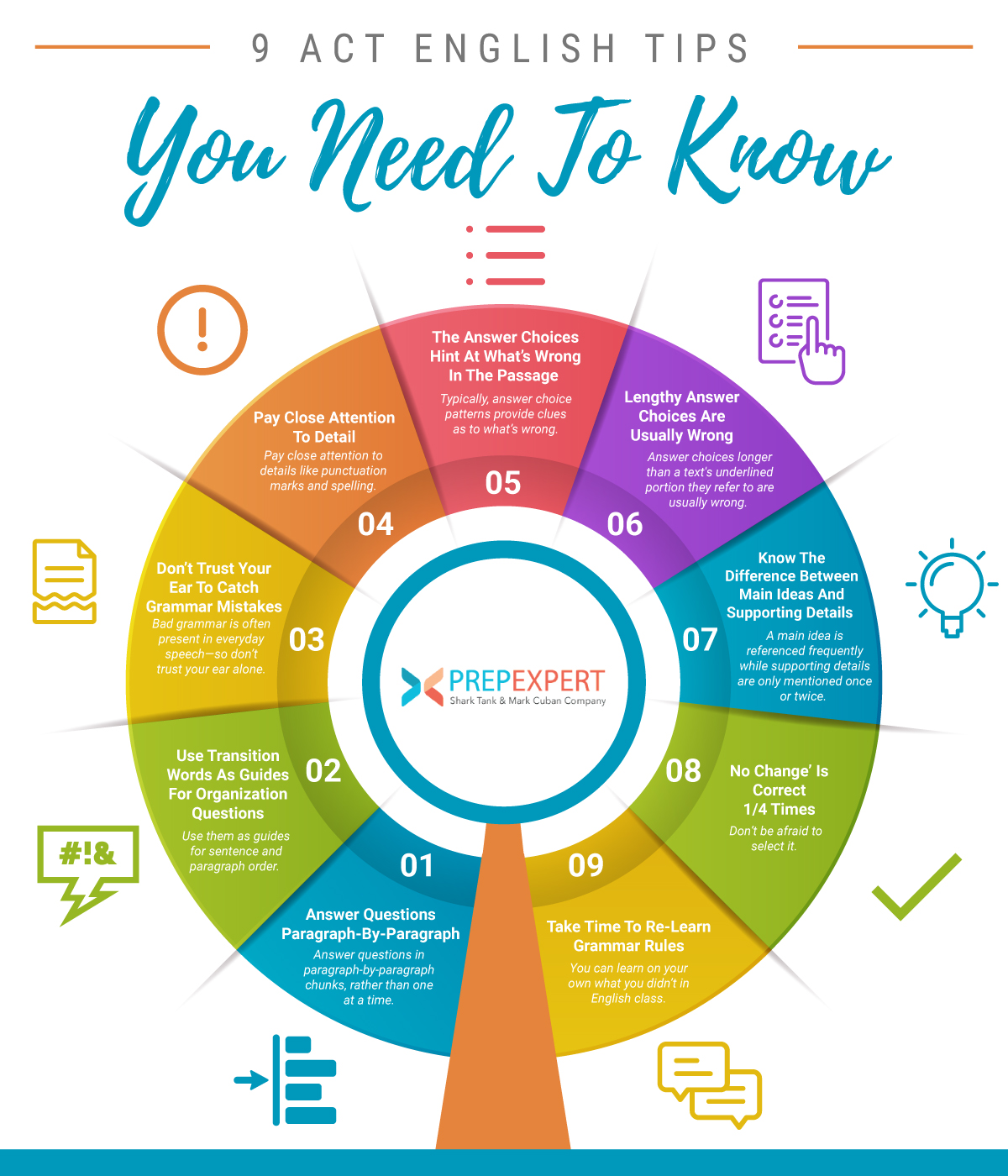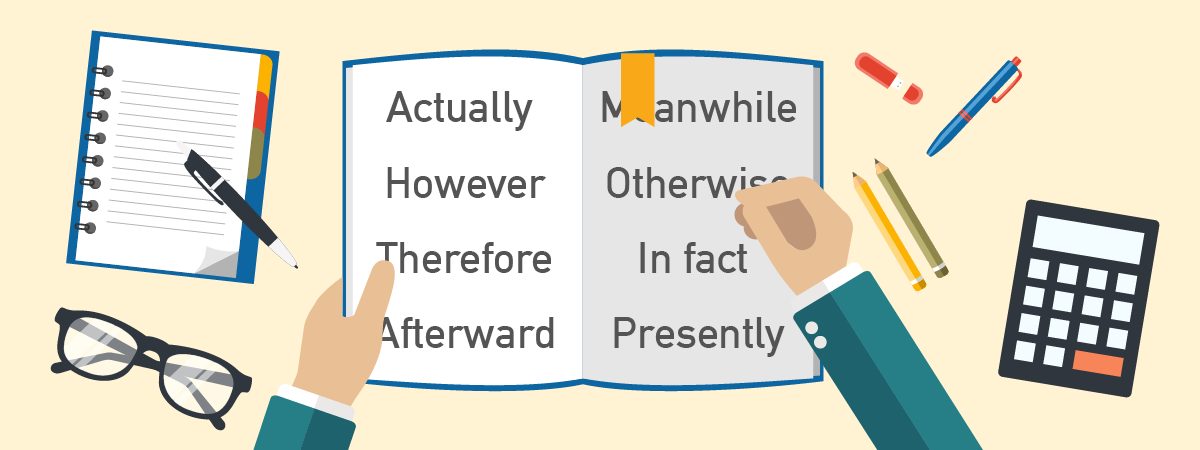9 ACT English Tips You Need to Know
Even if English is your least-favorite class, there’s no reason to sweat the ACT English test, the first part of the exam and the second-longest. Just follow the tips and tricks listed below, and you’ll be well on your way to a 36!
If you want to ace the ACT English test, brush up on the rules of grammar, answer questions in paragraph-by-paragraph chunks, and use answer choices as clues to what grammar and organization goofs you should be looking for in the passages.
More details below. For even more expert advice on the ACT English test, consider taking an ACT prep course with Prep Expert.
[act_one]


Answer Questions Paragraph-By-Paragraph
Answer questions in paragraph-by-paragraph chunks, rather than one at a time.
A bunch of the English test questions requires you to have read the entire paragraph the question is contained in—rather than the one or two sentences in between one question and the next—in order to answer them. These types of questions include those related to the main idea, paragraph organization, sentence order, maintaining tone, and eliminating redundancies, among others.
Therefore, as you complete the English test, it’s best to read entire paragraphs, and then answer the questions contained within. This way, you’ll have a grasp of the entire paragraph, and be able to answer these questions correctly.
Answering questions paragraph-by-paragraph will save you some time on the test, as well. While it might seem insignificant, you waste a considerable amount of time overall in switching back and forth between the exam booklet and your Scantron sheet to bubble in answers. If you answer questions in paragraph-by-paragraph chunks, then bubble in your answers, you’ll save a bit of this time.
You can even wait to answer an entire test booklet page worth of questions, and then bubble in your answers—just be sure to stay organized, and bubble your answers in the right places.

Use Transition Words As Guides For Organization Questions
Transition words and phrases tell you how words, sentences, and paragraphs relate to each other—use them as your guides for sentence and paragraph order and other organization questions.
By far, the toughest questions for my students on the English test are the organization questions—those where you’re asked to keep, add, delete, or move the order of sentences or paragraphs within a particular passage. The key to these questions is understanding the relationships between ideas, and transition words and phrases signal these relationships.
Transition words like ‘however’ and ‘but,’ for example, indicate a contrast. So, a sentence beginning with the word ‘however’ should follow a sentence it contrasts with; for example, “I got a C- in Physics last semester. However, I still made the Honor Roll.”
On the other hand, a transition word such as ‘therefore’ indicates an effect or a conclusion. So, the information preceding ‘therefore’ should provide evidence or a cause; for example, “I got a C- in Physics and a D in Calculus last semester. Therefore, I did not make Honor Roll.”
Furthermore, a transition word such as ‘then,’ which indicates order or time, helps place sentences in a logical order. For example, “Sign in with your username and password. Then, open up Safari to begin your research.”
Therefore, if you have a good understanding of the different types of transition words and phrases and how they are used, you should be able to use them as guideposts after you’ve read a paragraph, and are attempting to answer those otherwise tough organization questions.

Don’t Trust Your Ear To Catch Grammar Mistakes
We use bad grammar all the time in everyday speech—so don’t trust your ear to tell you if the grammar in a passage is correct.
Our casual conversations are loaded with grammar goofs; for example, people often misuse the word ‘everybody’ as a plural pronoun, when it is, in fact, a singular pronoun. So, while you might often hear sentences such as, “Everybody must bring their own lunch,” the grammatically correct sentence is, “Everybody must bring his or her own lunch.”
The ACT English test requires grammatical correctness, so be sure you have the rules of English grammar down pat, so you don’t need to rely on your ear.
On the other hand, if something sounds wrong, it’s almost always wrong. You can usually trust your ear to tell you whether writing is unidiomatic, awkward, or excessively verbose. So, if a section of the underlined text sounds bad, it probably contains a mistake, and you should look for an alternative in your list of answer choices.

Pay Close Attention To Detail
Pay close attention here—small details like punctuation marks and spelling make all the difference on the English test.
Every time I review a practice English test with my students, no matter how much I’ve belabored the point, a few students will still have answered questions about the difference between ‘its’ and ‘it’s’ incorrectly. (‘Its’ is a possessive pronoun, while ‘it’s’ is a contraction.)
[leadmagnet_five]
These students aren’t answering these questions incorrectly because they’re not smart enough to understand the difference; they’re answering incorrectly because they’re not paying close enough attention, and are therefore missing small details like these.
It’s important that you finish the English Test in time. However, it’s even more important that you answer the questions correctly. So, maintain a deliberate pace, and pay close attention to what you’re reading.
You’ll perform better this way than you will be speeding through the test, missing details like the difference between ‘it’s’ and ‘its,’ and losing lots of points in the process.
For what it’s worth, the English test isn’t particularly challenging, time-wise. Even though there are only 45 minutes to answer 75 questions, I find that most of my students have no trouble completing the test in time, even when they’ve kept a careful pace. So, don’t let time worries stress you out as you take this test.
[act_two]
The Answer Choices Hint At What’s Wrong In The Passage
Typically, a pattern in the answer choices will provide clues as to what’s wrong with the underlined portion of text you’re looking at—see if you notice a pattern, then search for the same type of mistake.
Oftentimes, all the answer choices for a particular question do the same thing—for example, move a modifier, or replace a pronoun. So, if you’re not sure what, if anything, is wrong with the underlined portion of text you’re looking at, look at the answer choices for a hint. If each answer choice adds a comma and a conjunction, for example, you should check to see if the underlined portion of text contains a comma splice.
[leadmagnet_two]
In addition, if two answer choices are synonymous, then they’re both wrong. Because only one of the four answer choices can be right, those that mean the same thing have to be incorrect. Remember this when you’re trying to narrow down your choices.

Lengthy Answer Choices Are Usually Wrong
Answer choices longer than the underlined portion of text they refer to are wrong more often than not.
This is because longer answers contain more room for errors. Oftentimes, longer answer choices correct the problem with the underlined text, only to add a different error.
Shorter answers, on the other hand, often eliminate redundancies and other grammatical errors. So, the correct answer is typically one with a length shorter than, or similar to, that of the underlined text.

Know The Difference Between A Main Idea And A Supporting Detail
The main idea of a paragraph or passage is referenced throughout while supporting details are mentioned only once or twice.
Remember this as you answer questions that ask you whether to move, keep, or delete a particular sentence—generally, a sentence should be kept if adds support for the main idea, and moved or deleted if it’s redundant, unnecessary, or off-topic.
In addition, if a question asks about the main idea of a paragraph or passage, you can rule out any answer choices that reference ideas mentioned only once or twice. Most incorrect answers to these types of questions will feature supporting details taken word-for-word from the passage. Don’t be fooled—generally, correct answers paraphrase or sum up the main idea, and won’t contain text verbatim from the passage.

‘No Change’ Is Correct 1/4 Times
‘No change’ is the correct answer one out of four times—don’t be afraid to select it.
Many students are uneasy with selecting ‘no change’ as an answer, thinking they’re just not noticing the mistake with an underlined portion of text. However, the English test is just as concerned with your ability to notice when something’s right as it is with your ability to pick up on mistakes.
So, if you’ve looked over the underlined portion of carefully, and there aren’t any problems as far as you can tell, then don’t hesitate to choose ‘no change’ as your answer. Like I said, this answer choice is correct one out of four times, so you’ll actually be selecting it quite a bit.
Take The Time To Re-Learn The Rules Of Grammar
Make no mistake—you can learn on your own what you didn’t in English class.
Every once in awhile, a concerned student approaches me and tells me that he or she never learned proper grammar in high school, and is worried this guarantees a poor English test score. If this describes you, don’t get too stressed out: while you will be playing catch-up, the rules of grammar tested on ACT English test are easy to learn with some focused studying.
Whether you’re starting from square one, or simply need a refresher, an ACT prep course with Prep Expert can provide you the grammar knowledge you’ll need to score a 36, even if your high school English classes fell short.
[act_three]
For more test strategy, college admissions, and scholarship application tips sign up for our FREE class happening right now!